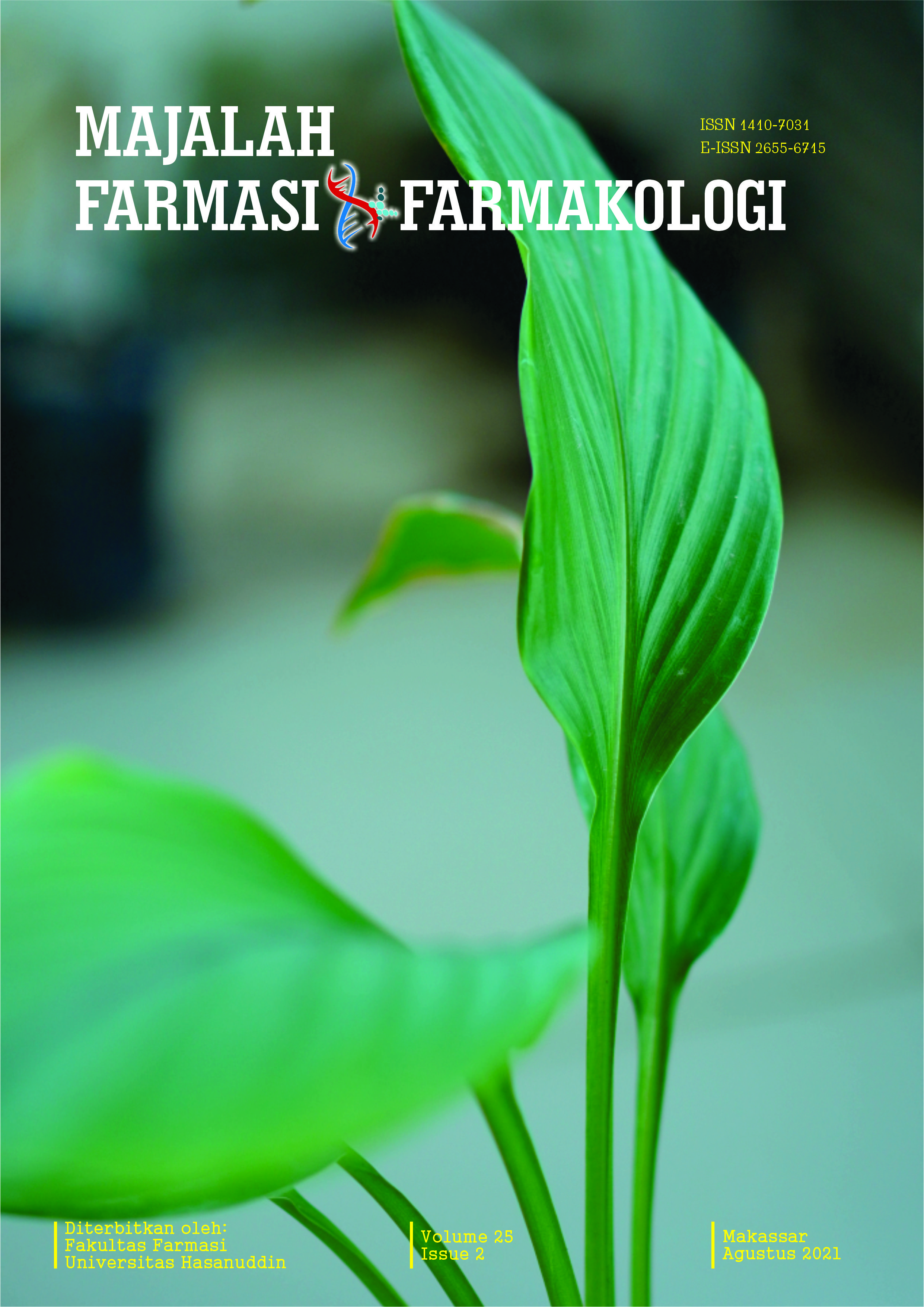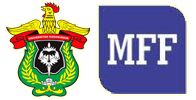REVIEW: PERAN KUNYIT (Curcuma longa) SEBAGAI TERAPI HIPERTENSI DAN MEKANISMENYA TERHADAP EKSPRESI GEN
Keywords:
Hipertensi, Curcuma longa, Curcumin, Ekspresi GenAbstract
Hipertensi adalah suatu keadaan dimana tekanan darah sistolik dan atau diastolik melebihi normal dan menjadi salah satu penyakit penyebab kematian tertinggi di dunia. Penggunaan obat-obatan sintetis dalam terapi hipertensi yang digunakan pada jangka panjang dapat menyebabkan efek samping, sehingga masyarakat mulai beralih menggunakan obat tradisional. Penggunaan kunyit (Curcuma longa) sebagai obat tradisional memiliki pengaruh yang baik karena kandungan salah satu komponen yang ada didalamnya yaitu curcumin mampu memperbaiki penyakit kardiovaskular termasuk hipertensi. Namun kajian tentang kunyit (Curcuma longa) sebagai obat tradisional masih dalam cakupan Obat Herbal Terstandar (OHT) dan belum sampai pada fitofarmaka. Curcumin bekerja dengan mempengaruhi berbagai target molekuler melalui interaksinya secara fisik dengan target atau dengan memodulasi faktor transkripsi, aktivitas enzim ataupun ekspresi gen. Ulasan ini merangkum peran kunyit (Curcuma longa) sebagai terapi hipertensi dan mekanismenya terhadap ekspresi gen dengan melakukan penelusuran jurnal ilmiah terpublikasi taraf internasional 10 tahun terakhir (2010-2020) melalui database elektronik berupa PubMed, ScienceDirect dan Google Scholar. Kunyit (Curcuma longa) dapat digunakan pada terapi hipertensi melalui perannya sebagai antioksidan, antiinflamasi, pencegah proliferasi sel otot polos pembuluh darah serta pada reseptor β-adrenergik dan beberapa mekanisme kerjanya terutama ke arah ekspresi gen eNOS, iNOS, ACE, AT1R, arginase, COX-2, Bcl-2 dan Caspase-3. Banyaknya manfaat dan potensi yang dimiliki kunyit (Curcuma longa) terutama perannya dalam mekanisme ekspresi gen pada hipertensi yang nantinya dapat dikembangkan lebih lanjut melalui berbagai pengujian.
References
Dominiczak AF, Kuo DRK. Hypertension: Update 2015. Hypertension. 2015;65(1):3–4.
Kemenkes RI. Riset Kesehatan Dasar [Internet]. Badan Penelitian dan Pengembangan Kesehatan. Jakarta: Kementrian Kesehatan RI; 2018. p. 198. Available from: http://labdata.litbang.kemkes.go.id/images/download/laporan/RKD/2018/Laporan_Nasional_RKD2018_FINAL.pdf
Triyono A, Zulkarnain Z, Mana TA. Studi Klinis Ramuan Jamu Antihipertensi pada Pasien Hipertensi Derajat I. J Kefarmasian Indones. 2018;8(1):17–25.
Setzer WN, Duong L, Poudel A, Mentreddy SR. Variation in the chemical composition of five varieties of curcuma longa rhizome essential oils cultivated in north alabama. Foods. 2020;10(2).
Correa F, Buelna-Chontal M, Hernández-Reséndiz S, García-Niño WR, Roldán FJ, Soto V, et al. Curcumin maintains cardiac and mitochondrial function in chronic kidney disease. Free Radic Biol Med. 2013;61(1):119–29.
Akter J, Islam MZ, Hossain MA, Kawabata S, Takara K, Nguyen HTT, et al. Endothelium-independent and calcium channel-dependent relaxation of the porcine cerebral artery by different species and strains of turmeric. J Tradit Complement Med [Internet]. 2019;9(4):297–303. Available from: https://doi.org/10.1016/j.jtcme.2018.08.002
Shishodia S. Molecular mechanisms of curcumin action: Gene expression. BioFactors. 2013;39(1):37–55.
Li R, Xiang C, Ye M, Li HF, Zhang X, Guo DA. Qualitative and quantitative analysis of curcuminoids in herbal medicines derived from Curcuma species. Food Chem [Internet]. 2011;126(4):1890–5. Available from: http://dx.doi.org/10.1016/j.foodchem.2010.12.014
Boonla O, Kukongviriyapan U, Pakdeechote P, Kukongviriyapan V, Pannangpetch P, Prachaney P, et al. Curcumin improves endothelial dysfunction and vascular remodeling in 2K-1C hypertensive rats by raising nitric oxide availability and reducing oxidative stress. Nitric Oxide - Biol Chem [Internet]. 2014;42:44–53. Available from: http://dx.doi.org/10.1016/j.niox.2014.09.001
Guo Y, An B, Lang Z, Zhou F, Zhang X, Wang H. Effects of curcumin on inhibiting the proliferation of pulmonary artery smooth muscle cells and relieving pulmonary arterial hypertension. Farmacia. 2020;68(2):307–12.
Bronte E, Coppola G, Di Miceli R, Sucato V, Russo A, Novo S. Role of curcumin in idiopathic pulmonary arterial hypertension treatment: A new therapeutic possibility. Med Hypotheses [Internet]. 2013;81(5):923–6. Available from: http://dx.doi.org/10.1016/j.mehy.2013.08.016
Leong XF. The spice for hypertension: Protective role of Curcuma longa. Biomed Pharmacol J. 2018;11(4):1829–40.
Akinyemi AJ, Thome GR, Morsch VM, Stefanello N, Goularte JF, Belló-Klein A, et al. Effect of dietary supplementation of ginger and turmeric rhizomes on angiotensin-1 converting enzyme (ACE) and arginase activities in L-NAME induced hypertensive rats. J Funct Foods [Internet]. 2015;17:792–801. Available from: http://dx.doi.org/10.1016/j.jff.2015.06.011
Hlavačková L, Janegová A, Uličná O, Janega P, Černá A, Babál P. Spice up the hypertension diet - Curcumin and piperine prevent remodeling of aorta in experimental L-NAME induced hypertension. Nutr Metab. 2011;8:1–10.
Han Y, Sun HJ, Tong Y, Chen YZ, Ye C, Qiu Y, et al. Curcumin attenuates migration of vascular smooth muscle cells via inhibiting NFκB-mediated NLRP3 expression in spontaneously hypertensive rats. J Nutr Biochem [Internet]. 2019;72:108212. Available from: https://doi.org/10.1016/j.jnutbio.2019.07.003
Akinyemi AJ, Thomé GR, Morsch VM, Bottari NB, Baldissarelli J, De Oliveira LS, et al. Effect of Ginger and Turmeric Rhizomes on Inflammatory Cytokines Levels and Enzyme Activities of Cholinergic and Purinergic Systems in Hypertensive Rats. Planta Med. 2016;82(7):612–20.
Ren XS, Tong Y, Ling L, Chen D, Sun HJ, Zhou H, et al. NLRP3 Gene Deletion Attenuates Angiotensin II-Induced Phenotypic Transformation of Vascular Smooth Muscle Cells and Vascular Remodeling. Cell Physiol Biochem. 2018;44(6):2269–80.
Lai PEIC, Chiu TEDH, Huang YENTA. Overexpression of BDNF and TrkB in human. Anticancer Res. 2010;31(12):1265–70.
Da Costa CA, De Oliveira PRB, De Bem GF, De Cavalho LCRM, Ognibene DT, Da Silva AFE, et al. Euterpe oleracea Mart.-derived polyphenols prevent endothelial dysfunction and vascular structural changes in renovascular hypertensive rats: Role of oxidative stress. Naunyn Schmiedebergs Arch Pharmacol. 2012;385(12):1199–209.
Adaramoye OA, Nwosu IO, Farombi EO. Sub-acute effect of N G-nitro-l-arginine methyl-ester (L-NAME) on biochemical indices ins rats: Protective effects of Kolaviron and extract of Curcuma longa L. Pharmacognosy Res. 2012;4(3):127–33.
Tapia E, Zatarain-Barrón ZL, Hernández-Pando R, Zarco-Márquez G, Molina-Jijón E, Cristóbal-García M, et al. Curcumin reverses glomerular hemodynamic alterations and oxidant stress in 5/6 nephrectomized rats. Phytomedicine [Internet]. 2013;20(3–4):359–66. Available from: http://dx.doi.org/10.1016/j.phymed.2012.11.014
Moohammadaree A, Changtam C, Wicha P, Suksamrarn A, Tocharus J, Tocharus C. Mechanisms of Vasorelaxation Induced by Hexahydrocurcuminin Isolated Rat Thoracic Aorta. Phyther Res. 2015;29(11):1806–13.
Sun T, Liu R, Cao YX. Vasorelaxant and antihypertensive effects of formononetin through endothelium-dependent and -independent mechanisms. Acta Pharmacol Sin [Internet]. 2011;32(8):1009–18. Available from: http://dx.doi.org/10.1038/aps.2011.51
Nakmareong S, Kukongviriyapan U, Pakdeechote P, Donpunha W, Kukongviriyapan V, Kongyingyoes B, et al. Antioxidant and vascular protective effects of curcumin and tetrahydrocurcumin in rats with L-NAME-induced hypertension. Naunyn Schmiedebergs Arch Pharmacol. 2011;383(5):519–29.
Kukongviriyapan U, Pannangpetch P, Kukongviriyapan V, Donpunha W, Sompamit K, Surawattanawan P. Curcumin protects against cadmium-induced vascular dysfunction, hypertension and tissue cadmium accumulation in mice. Nutrients. 2014;6(3):1194–208.
Pang XF, Zhang LH, Bai F, Wang NP, Garner RE, McKallip RJ, et al. Attenuation of myocardial fibrosis with curcumin is mediated by modulating expression of angiotensin II AT1/AT2 receptors and ACE2 in rats. Drug Des Devel Ther. 2015;9:6043–54.
Lekshmi PC, Arimboor R, Nisha VM, Menon AN, Raghu KG. In vitro antidiabetic and inhibitory potential of turmeric (Curcuma longa L) rhizome against cellular and LDL oxidation and angiotensin converting enzyme. J Food Sci Technol. 2014;51(12):3910–7.
Hye Lin Kim 1, Woo Kyoung Kim 1 and Ae Wha Ha 2 *. Effects of Phytochemicals on Blood Pressure and Neuroprotection Mediated Via Brain Renin-Angiotensin System. Nutr Artic. 2019;11:1–13.
Chugh G, Lokhandwala MF, Asghar M. Oxidative stress alters renal D1 and AT1 receptor functions and increases blood pressure in old rats. Am J Physiol - Ren Physiol. 2011;300(1):133–9.
Greish SM, Abdel-hady Z, Mohammed SS, Abdel-hamed AR, Masoud RE. Protective potential of curcumin in L-NAME-induced hypertensive rat model : AT1R , mitochondrial DNA synergy. Int J Pathophysiol Pharmacol. 2020;12(5):134–46.
Yao Y, Wang W, Li M, Ren H, Chen C, Wang J, et al. Curcumin Exerts its Anti-hypertensive Effect by Down-regulating the AT1 Receptor in Vascular Smooth Muscle Cells. Sci Rep [Internet]. 2016;6(April):1–8. Available from: http://dx.doi.org/10.1038/srep25579
Peyton KJ, Liu X ming, Shebib AR, Johnson FK, Johnson RA, Durante W. Arginase inhibition prevents the development of hypertension and improves insulin resistance in obese rats. Amino Acids [Internet]. 2018;50(6):747–54. Available from: https://doi.org/10.1007/s00726-018-2567-x
Zhou H, S. Beevers C, Huang S. The Targets of Curcumin. Curr Drug Targets. 2012;12(3):332–47.
Silva V, Tranmer J, Schirmer J, Dhanani S, Almost J, Schafer M, et al. CHANGES OF CASPASE-3, BAX, BCL-2, CHEMOKINE RECEPTOR-2, MONOCYTE CHMOATTRACTANT PROTEIN-1, AND TRANSFORMING GROWTH FACTOR GENES IN SPONTANEOUSLY HYPERTENSIVE RAT AFTER LOSARTAN TREATMENT. 2016;34(September):391–2.
Wong SL, Lau CW, Wong WT, Xu A, Au CL, Ng CF, et al. Pivotal role of protein kinase Cδ in angiotensin II-induced endothelial cyclooxygenase-2 expression: A link to vascular inflammation. Arterioscler Thromb Vasc Biol. 2011;31(5):1169–76.
Li J, Sun M, Ye J, Li Y, Jin R, Zheng H, et al. The Mechanism of Acupuncture in Treating Essential Hypertension: A Narrative Review. Int J Hypertens. 2019;2019.
Wong WT, Tian XY, Chen Y, Leung FP, Liu L, Lee HK, et al. Bone morphogenic protein-4 impairs endothelial function through oxidative stress-dependent cyclooxygenase-2 upregulation: Implications on hypertension. Circ Res. 2010;107(8):984–91.
Buhrmann C, Mobasheri A, Busch F, Aldinger C, Stahlmann R, Montaseri A, et al. Curcumin modulates nuclear factor κB (nf-κB)-mediated inflammation in human tenocytes in vitro: Role of the phosphatidylinositol 3-kinase/Akt pathway. J Biol Chem [Internet]. 2011;286(32):28556–66. Available from: http://dx.doi.org/10.1074/jbc.M111.256180
Downloads
Published
Issue
Section
License
Copyright (c) 2021 Majalah Farmasi dan Farmakologi

This work is licensed under a Creative Commons Attribution-NonCommercial 4.0 International License.
The copyright to this article is transferred to Universitas Hasanuddin (UNHAS) if and when the article is accepted for publication. The undersigned hereby transfers all rights in and to the paper including without limitation all copyrights to UNHAS. The undersigned hereby represents and warrants that the paper is original and that he/she is the author of the paper, except for material that is clearly identified as to its original source, with permission notices from the copyright owners where required. The undersigned represents that he/she has the power and authority to make and execute this assignment.
We declare that:
- This paper has not been published in the same form elsewhere.
- It will not be submitted anywhere else for publication prior to acceptance/rejection by this Journal.
- A copyright permission is obtained for materials published elsewhere and which require this permission for reproduction.
Furthermore, I/We hereby transfer the unlimited rights of publication of the above-mentioned paper in whole to UNHAS The copyright transfer covers the exclusive right to reproduce and distribute the article, including reprints, translations, photographic reproductions, microform, electronic form (offline, online) or any other reproductions of similar nature.
The corresponding author signs for and accepts responsibility for releasing this material on behalf of any and all co-authors. This agreement is to be signed by at least one of the authors who have obtained the assent of the co-author(s) where applicable. After submission of this agreement signed by the corresponding author, changes of authorship or in the order of the authors listed will not be accepted.


